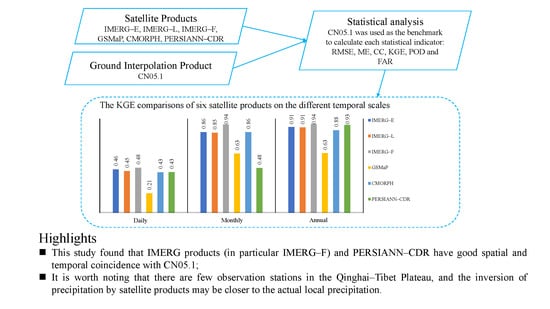Evaluation of Six Satellite Precipitation Products over the Chinese Mainland
Abstract
1. Introduction
2. Materials and Methods
2.1. Ground Interpolation Product Production
2.2. Satellite Precipitation Products
2.3. Metrics for Precipitation Product Quality
3. Results
3.1. Daily Precipitation
3.2. Monthly and Seasonal Precipitation
3.3. Annual Precipitation
4. Discussion
5. Conclusions
- For the correlation coefficient (CC), the fluctuation range of each product on the daily scale was 0.3–0.5, the monthly scale was 0.63–0.95, and the annual scale was 0.72–0.95. The correlation between satellite products and CN05.1 was significantly improved from day to year. The CC of IMERG–F was generally better than that of IMERG–E and IMERG–F, which showed that the station correction can significantly improve the accuracy of satellite precipitation products. IMERG–F was only slightly worse than PERSIANN–CDR at the daily scale, but its RMSE, ME, and CC were all optimal at the other scales. Especially at the monthly scale, the error ME of IMERG was almost 0. The high POD and FAR on the daily scale indicated that it may improve the hit rate of precipitation events through a large number of forecasts but at the same time make the false alarm rate higher.
- In terms of spatial distribution, all products can trace the precipitation difference between southeast and northwest China. IMERG products and PERSIANN–CDR can even better depict the precipitation lines in China. GSMaP overestimated the precipitation in western and northwestern China and even overestimated it in spring and winter across mainland China. In spring and winter, IMERG products significantly underestimated the precipitation in northwest China. It is worth noting that there are few observation stations in the Qinghai–Tibet Plateau, and the inversion of precipitation by satellite products may be closer to the actual local precipitation.
- CN05.1 site interpolation data showed that the probability of precipitation in mainland China was 22.7%, and the closest was GSMaP (19.6%), followed by PERSIANN–CDR (25.9%). This study also found that most of the mean annual precipitation was less than 16 mm/day. However, within the range of 1–16 mm/day precipitation, only PERSIANN–CDR was more than CN05.1, and other products were 0–25% less than CN05.1. The underestimation of precipitation less than 16 mm/day was also reflected in the monthly and annual scatter plots. All products were consistent with the trend of CN05.1 in the range of 4–128 mm/day, and almost all products had strong prediction ability for moderate and heavy precipitation.
- All satellite precipitation products can well capture the seasonal variation in precipitation. The monthly precipitation of IMERG products and CMORPH was in good agreement with CN05.1. while PERSIANN–CDR showed overestimation of precipitation and GSMaP overestimation in the dry season and underestimation in the rainy season.
- This study found that IMERG products (in particular IMERG–F) and PERSIANN–CDR have good spatial and temporal coincidence with CN05.1, which can be applied to many fields, such as hydrology, meteorology, and disaster prediction in the Chinese mainland. Second, CMORPH also showed good performance in southeast, northeast, and East China.
Author Contributions
Funding
Data Availability Statement
Conflicts of Interest
References
- Subash, N.; Ram Mohan, H.S. Trend detection in rainfall and evaluation of standardized precipitation index as a drought assessment index for rice–wheat productivity over IGR in India. Int. J. Climatol. 2011, 31, 1694–1709. [Google Scholar] [CrossRef]
- Tang, G.; Zeng, Z.; Ma, M.; Liu, R.; Wen, Y.; Hong, Y. Can near-real-time satellite precipitation products capture rainstorms and guide flood warning for the 2016 summer in south China? IEEE Geosci. Remote Sens. Lett. 2017, 14, 1208–1212. [Google Scholar] [CrossRef]
- Zou, W.; Han, X.; Jiang, H.; Yang, C. Characteristics of precipitation in black soil region and response of soil moisture dynamics in Northeast China. Trans. Chin. Soc. Agric. Eng. 2011, 27, 196–202. [Google Scholar] [CrossRef]
- Yordanova, N.; Guerova, G.; Stoycheva, A. Application of GNSS Meteorology for Intense Precipitation Case Studies in Bulgaria. Available online: http://suada.phys.uni-sofia.bg/wordpress/wp-content/uploads/2015/02/yordanova_et_al_2013.pdf (accessed on 30 August 2022).
- Yang, P.; Xia, J.; Zhang, Y.; Hong, S. Temporal and spatial variations of precipitation in Northwest China during 1960–2013. Atmos. Res. 2017, 183, 283–295. [Google Scholar] [CrossRef]
- Liao, R.; Zhang, D.; Shen, Y. Validation of six satellite-derived rainfall estimates over China. Meteorology 2015, 41, 970–979. [Google Scholar]
- Ba, M.B.; Gruber, A. GOES Multispectral Rainfall Algorithm (GMSRA). J. Appl. Meteorol. 2001, 40, 1500–1514. [Google Scholar] [CrossRef]
- Ebert, E.E.; Manton, M.J. Performance of satellite rainfall estimation algorithms during TOGA COARE. J. Atmos. Sci. 1998, 55, 1537–1557. [Google Scholar] [CrossRef]
- Kummerow, C.; Hong, Y.; Olson, W.S.; Yang, S.; Adler, R.F.; Mccollum, J.; Ferraro, R.; Petty, G.; Shin, D.B.; Wilheit, T.T. The evolution of the Goddard Profiling Algorithm (GPROF) for rainfall estimation from passive microwave sensors. J. Appl. Meteorol. 2001, 40, 1801–1802. [Google Scholar] [CrossRef]
- Fangcheng, Z.; Xiaoning, S.; Zhaoliang, L. Progress of land surface temperature retrieval based on passive microwave remote sensing. Remote Sens. Nat. Resour. 2014, 26, 1–7. [Google Scholar] [CrossRef]
- Prigent, C. Precipitation retrieval from space: An overview. Comptes Rendus Geosci. 2010, 342, 380–389. [Google Scholar] [CrossRef]
- Iguchi, T.; Kozu, T.; Kwiatkowski, J.; Meneghini, R.; Awaka, J.; Okamoto, K. Uncertainties in the rain profiling algorithm for the TRMM precipitation radar. J. Meteorol. Soc. Jpn. Ser. II 2009, 87A, 1–30. [Google Scholar] [CrossRef]
- Joyce, R.J.; Janowiak, J.E.; Arkin, P.A.; Xie, P. CMORPH: A method that produces global precipitation estimates from passive microwave and infrared data at high spatial and temporal resolution. J. Hydrometeorol. 2004, 5, 487–503. [Google Scholar] [CrossRef]
- Stephens, G.L.; Kummerow, C.D. The remote sensing of clouds and precipitation from space: A review. J. Atmos. Sci. 2007, 64, 3742–3765. [Google Scholar] [CrossRef]
- Arkin, P.; Turk, J.; Ebert, B. Pilot Evaluation of High Resolution Precipitation Products (PEHRPP): A Contribution to GPM Planning. 2005. Available online: https://www.researchgate.net/profile/Phillip-Arkin/publication/228414351_Pilot_Evaluation_of_High_Resolution_Precipitation_Products_PEHRPP_A_Contribution_to_GPM_Planning/links/0912f512f6f4fa1f49000000/Pilot-Evaluation-of-High-Resolution-Precipitation-Products-PEHRPP-A-Contribution-to-GPM-Planning.pdf (accessed on 8 September 2022).
- Turk, J.; Arkin, P.; Ebert, E.; Sapiano, M.R.P. Evaluating high resolution precipitation products. Bull. Am. Meteorol. Soc. 2008, 89, 1911–1916. [Google Scholar] [CrossRef]
- Huffman, G.J.; Adler, R.F.; Morrissey, M.M.; Bolvin, D.T.; Curtis, S.; Joyce, R.; McGavock, B.; Susskind, J. Global Precipitation at One-Degree Daily Resolution from Multisatellite Observations. J. Hydrometeorol. 2001, 2, 36–50. [Google Scholar] [CrossRef]
- Weymouth, G.; Mills, G.; Jones, D.; Ebert, E.; Manton, M. A continenta-scale daily rainfall analysis system. Aust. Meteorol. Mag. 1999, 48, 169–179. [Google Scholar]
- Kidd, C.; Kniveton, D.R.; Todd, M.C.; Bellerby, T.J. Satellite rainfall estimation using combined passive microwave and infrared algorithms. J. Hydrometeorol. 2003, 4, 1088–1104. [Google Scholar] [CrossRef]
- Makihara, Y. A method for improving radar estimates of precipitation by comparing data from radars and raingauges. J. Meteorol. Soc. Jpn. Ser. II 1996, 74, 459–480. [Google Scholar] [CrossRef]
- Krakauer, N.; Pradhanang, S.; Lakhankar, T.; Jha, A. Evaluating satellite products for precipitation estimation in mountain regions: A case study for Nepal. Remote Sens. 2013, 5, 4107–4123. [Google Scholar] [CrossRef]
- Ringard, J.; Becker, M.; Seyler, F.; Linguet, L. Temporal and spatial assessment of four satellite rainfall estimates over French Guiana and north Brazil. Remote Sens. 2015, 7, 16441–16459. [Google Scholar] [CrossRef]
- Serrat-Capdevila, A.; Merino, M.; Valdes, J.; Durcik, M. Evaluation of the Performance of Three Satellite Precipitation Products over Africa. Remote Sens. 2016, 8, 836. [Google Scholar] [CrossRef]
- Li, J.; Hsu, K.-L.; AghaKouchak, A.; Sorooshian, S. Object-based assessment of satellite precipitation products. Remote Sens. 2016, 8, 547. [Google Scholar] [CrossRef]
- Tan, M.; Duan, Z. Assessment of GPM and TRMM precipitation products over Singapore. Remote Sens. 2017, 9, 720. [Google Scholar] [CrossRef]
- Dandridge, C.; Lakshmi, V.; Bolten, J.; Srinivasan, R. Evaluation of satellite-based rainfall estimates in the lower Mekong river basin (southeast Asia). Remote Sens. 2019, 11, 2709. [Google Scholar] [CrossRef]
- Wild, A.; Chua, Z.-W.; Kuleshov, Y. Evaluation of satellite precipitation estimates over the south west pacific region. Remote Sens. 2021, 13, 3929. [Google Scholar] [CrossRef]
- Lu, D.; Yong, B. Evaluation and hydrological utility of the latest GPM IMERG V5 and GSMaP V7 precipitation products over the tibetan plateau. Remote Sens. 2018, 10, 2022. [Google Scholar] [CrossRef]
- Zhang, Z.; Tian, J.; Huang, Y.; Chen, X.; Chen, S.; Duan, Z. Hydrologic Evaluation of TRMM and GPM IMERG satellite-based precipitation in a humid basin of China. Remote Sens. 2019, 11, 431. [Google Scholar] [CrossRef]
- Zhang, L.; Xin, Z.; Zhou, H. Assessment of TMPA 3B42V7 and PERSIANN-CDR in Driving Hydrological Modeling in a Semi-Humid Watershed in Northeastern China. Remote Sens. 2020, 12, 3133. [Google Scholar] [CrossRef]
- Guo, H.; Li, M.; Nzabarinda, V.; Bao, A.; Meng, X.; Zhu, L.; De Maeyer, P. Assessment of three long-term satellite-based precipitation estimates against ground observations for drought characterization in northwestern China. Remote Sens. 2022, 14, 828. [Google Scholar] [CrossRef]
- Li, S.; Jiang, C.; Ma, Y.; Long, Y.; Wu, R.; Zhu, Q.; Li, D.; Li, C.; Ning, Z. Adaptation analysis in IMERG precipitation estimation for the Dongting Lake Basin, China. Atmosphere 2022, 13, 1735. [Google Scholar] [CrossRef]
- Liu, J.; Duan, Z.; Jiang, J.; Zhu, A. Evaluation of three satellite precipitation products TRMM 3B42, CMORPH, and PERSIANN over a subtropical watershed in China. Adv. Meteorol. 2015, 2015, 151239. [Google Scholar] [CrossRef]
- Bai, L.; Shi, C.; Li, L.; Yang, Y.; Wu, J. Accuracy of CHIRPS satellite-rainfall products over mainland China. Remote Sens. 2018, 10, 362. [Google Scholar] [CrossRef]
- Chen, F.; Li, X. Evaluation of IMERG and TRMM 3B43 monthly precipitation products over mainland China. Remote Sens. 2016, 8, 472. [Google Scholar] [CrossRef]
- Li, Y.; Guo, B.; Wang, K.; Wu, G.; Shi, C. Performance of TRMM product in quantifying frequency and intensity of precipitation during daytime and nighttime across China. Remote Sens. 2020, 12, 740. [Google Scholar] [CrossRef]
- Wei, L.; Jiang, S.; Ren, L.; Zhang, L.; Wang, M.; Duan, Z. Preliminary utility of the retrospective IMERG precipitation product for Large-scale drought monitoring over mainland China. Remote Sens. 2020, 12, 2993. [Google Scholar] [CrossRef]
- Chen, J.; Wang, Z.; Wu, X.; Lai, C.; Chen, X. Evaluation of TMPA 3B42-V7 product on extreme precipitation estimates. Remote Sens. 2021, 13, 209. [Google Scholar] [CrossRef]
- Su, J.; Lü, H.; Zhu, Y.; Wang, X.; Wei, G. Component analysis of errors in four GPM-based precipitation estimations over mainland China. Remote Sens. 2018, 10, 1420. [Google Scholar] [CrossRef]
- Wu, Z.; Xu, Z.; Wang, F.; He, H.; Zhou, J.; Wu, X.; Liu, Z. Hydrologic evaluation of multi-source satellite precipitation products for the upper Huaihe river basin, China. Remote Sens. 2018, 10, 840. [Google Scholar] [CrossRef]
- Xu, F.; Guo, B.; Ye, B.; Ye, Q.; Chen, H.; Ju, X.; Guo, J.; Wang, Z. Systematical evaluation of GPM IMERG and TRMM 3B42V7 precipitation products in the Huang-Huai-Hai plain, China. Remote Sens. 2019, 11, 697. [Google Scholar] [CrossRef]
- Qin, Y.; Chen, Z.; Shen, Y.; Zhang, S.; Shi, R. Evaluation of satellite rainfall estimates over the Chinese mainland. Remote Sens. 2014, 6, 11649–11672. [Google Scholar] [CrossRef]
- Xu, J.; Ma, Z.; Tang, G.; Ji, Q.; Min, X.; Wan, W.; Shi, Z. Quantitative evaluations and error source analysis of fengyun-2-based and gpm-based precipitation products over mainland China in summer, 2018. Remote Sens. 2019, 11, 2992. [Google Scholar] [CrossRef]
- Wu, J.; Gao, X. A gridded daily observation dataset over China region and comparison with the other datasets. Chin. J. Geophys. 2013, 56, 1102–1111. [Google Scholar]
- Zhou, B.; Xu, Y.; Wu, J.; Dong, S.; Shi, Y. Changes in temperature and precipitation extreme indices over China: Analysis of a high-resolution grid dataset. Int. J. Climatol. 2016, 36, 1051–1066. [Google Scholar] [CrossRef]
- Varikoden, H.; Preethi, B.; Samah, A.A.; Babu, C.A. Seasonal variation of rainfall characteristics in different intensity classes over Peninsular Malaysia. J. Hydrol. 2011, 404, 99–108. [Google Scholar] [CrossRef]
- Huffman, G.J.; Bolvin, D.T.; Nelkin, E.J. Integrated Multi-Satellite Retrievals for GPM (IMERG) Technical Documentation; NASA/GSFC: Greenbelt, MD, USA, 2017.
- Tan, J.; Petersen, W.A.; Kirstetter, P.E.; Tian, Y.D. Performance of IMERG as a function of spatiotemporal scale. J. Hydrometeorol. 2016, 18, 307–319. [Google Scholar] [CrossRef]
- Aonashi, K.; Awaka, J.; Hirose, M.; Kozu, T.; Kubota, T.; Liu, G.; Shige, S.; Kida, S.; Seto, S.; Takahashi, N.; et al. GSMaP passive microwave precipitation retrieval algorithm: Algorithm description and validation. J. Meteorol. Soc. Jpn. Ser. II 2009, 87A, 119–136. [Google Scholar] [CrossRef]
- Noor, M.; Ismail, T.; Shahid, S.; Asaduzzaman, M.; Dewan, A. Evaluating intensity-duration-frequency (IDF) curvesof satellite-based precipitation datasets in Peninsular Malaysia. Atmos. Res. 2021, 248, 105203. [Google Scholar] [CrossRef]
- Ayoub, A.B.; Tangang, F.; Juneng, L.; Tan, M.L.; Chung, J.X. Evaluation of Gridded Precipitation Datasets in Malaysia. Remote Sens. 2020, 12, 613. [Google Scholar] [CrossRef]
- Wang, F.; Yang, H.; Wang, Z.; Zhang, Z.; Li, Z. Drought evaluation with CMORPH satellite precipitation data in the Yellow River basin by using gridded standardized precipitation evapotranspiration index. Remote Sens. 2019, 11, 485. [Google Scholar] [CrossRef]
- Wild, A.; Chua, Z.-W.; Kuleshov, Y. Triple collocation analysis of satellite precipitation estimates over Australia. Remote Sens. 2022, 14, 2724. [Google Scholar] [CrossRef]
- Ebert, E.E.; Janowiak, J.E.; Kidd, C. Comparison of near-real-time precipitation estimates from satellite observations and numerical models. Bull. Am. Meteorol. Soc. 2007, 88, 7. [Google Scholar] [CrossRef]
- Dinku, T.; Ruiz, F.; Connor, S.J.; Ceccato, P. Validation and intercomparison of satellite rainfall estimates over Colombia. J. Appl. Meteorol. Climatol. 2010, 49, 1004–1014. [Google Scholar] [CrossRef]
- Xie, P.; Chen, M.; Yang, S.; Yatagai, A.; Hayasaka, T.; Fukushima, Y.; Liu, C. A gauge-based analysis of daily precipitation over East Asia. J. Hydrometeorol. 2007, 8, 607–626. [Google Scholar] [CrossRef]
- Gosset, M.; Viarre, J.; Quantin, G.; Alcoba, M. Evaluation of several rainfall products used for hydrological applications over West Africa using two high-resolution gauge networks. Q. J. R. Meteorol. Soc. 2013, 139, 923–940. [Google Scholar] [CrossRef]
- Moazami, S.; Golian, S.; Kavianpour, M.R.; Hong, Y. Comparison of PERSIANN and V7 TRMM Multi-satellite Precipitation Analysis (TMPA) products with rain gauge data over Iran. Int. J. Remote Sens. 2013, 34, 8156–8171. [Google Scholar] [CrossRef]
- McCollum, J.R.; Gruber, A.; Ba, M.B. Discrepancy between gauges and satellite estimates of rainfall in Equatorial Africa. J. Appl. Meteorol. 2000, 39, 666–679. [Google Scholar] [CrossRef]
- Chua, Z.-W.; Kuleshov, Y.; Watkins, A. Evaluation of satellite precipitation estimates over Australia. Remote Sens. 2020, 12, 678. [Google Scholar] [CrossRef]
- Behrangi, A.; Khakbaz, B.; Jaw, T.C.; AghaKouchak, A.; Hsu, K.; Sorooshian, S. Hydrologic evaluation of satellite precipitation products over a mid-size basin. J. Hydrol. 2011, 397, 225–237. [Google Scholar] [CrossRef]
- AghaKouchak, A.; Behrangi, A.; Sorooshian, S.; Hsu, K.; Amitai, E. Evaluation of satellite-retrieved extreme precipitation rates across the central United States. J. Geophys. Res. 2011, 116, D02115. [Google Scholar] [CrossRef]
- Kidd, C.; Bauer, P.; Turk, J.; Huffman, G.J.; Joyce, R.; Hsu, K.L.; Braithwaite, D. Intercomparison of high-resolution precipitation products over northwest Europe. J. Hydrometeorol. 2012, 13, 67–83. [Google Scholar] [CrossRef]
- Sorooshian, S.; AghaKouchak, A.; Arkin, P.; Eylander, J.; Foufoula-Georgiou, E.; Harmon, R.; Hendrickx, J.M.H.; Imam, B.; Kuligowski, R.; Skahill, B.; et al. Advancing the remote sensing of precipitation. Bull. Am. Meteorol. Soc. 2011, 92, 1271–1272. [Google Scholar] [CrossRef]
- Gebregiorgis, A.S.; Hossain, F. Understanding the dependence of satellite rainfall uncertainty on topography and climate for hydrologic model simulation. IEEE Trans. Geosci. Remote Sens. 2013, 51, 704–718. [Google Scholar] [CrossRef]
- Nasrollahi, N.; Hsu, K.; Sorooshian, S. An artificial neural network model to reduce false alarms insatellite precipi-tation products using MODIS and CloudSat observations. J. Hydrometeorol. 2013, 14, 1872–1883. [Google Scholar] [CrossRef]
- Massari, C.; Crow, W.; Brocca, L. An assessment of the performance of global rainfall estimates without ground-based observations. Hydrol. Earth Syst. Sci. 2017, 21, 4347–4361. [Google Scholar] [CrossRef]
- Alemohammad, S.H.; McColl, K.A.; Konings, A.G.; Entekhabi, D.; Stoffelen, A. Characterization of precipitation product errorsacross the United States using multiplicative triple collocation. Hydrol. Earth Syst. Sci. 2015, 19, 3489–3503. [Google Scholar] [CrossRef]
- Pfeifroth, U.; Mueller, R.; Ahrens, B. Evaluation of satellite-based and reanalysis precipitation data in the tropical Pacific. J. Appl. Meteorol. Climatol. 2013, 52, 634–644. [Google Scholar] [CrossRef]
- Beck, H.E.; van Dijk, A.I.J.M.; Levizzani, V.; Schellekens, J.; Miralles, D.G.; Martens, B.; de Roo, A. MSWEP: 3-hourly 0.25° global gridded precipitation (1979–2015) by merging gauge, satellite, and reanalysis data. Hydrol. Earth Syst. Sci. 2017, 21, 589–615. [Google Scholar] [CrossRef]
- Zhang, X.; Tang, Q.; Pan, M.; Tang, Y. A long-term land surface hydrologic fluxes and states dataset for China. J. Hydrometeorol. 2014, 15, 2067–2084. [Google Scholar] [CrossRef]
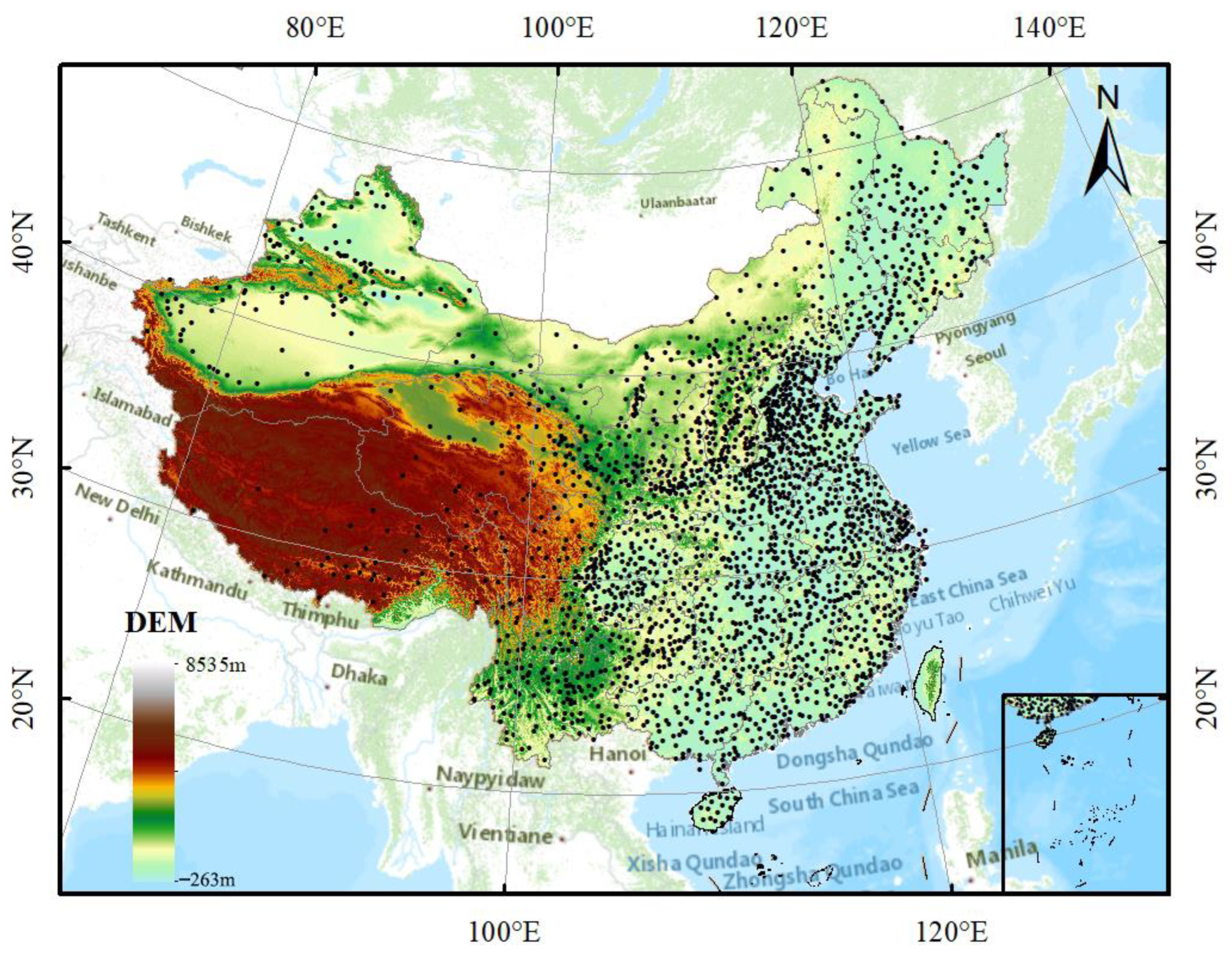

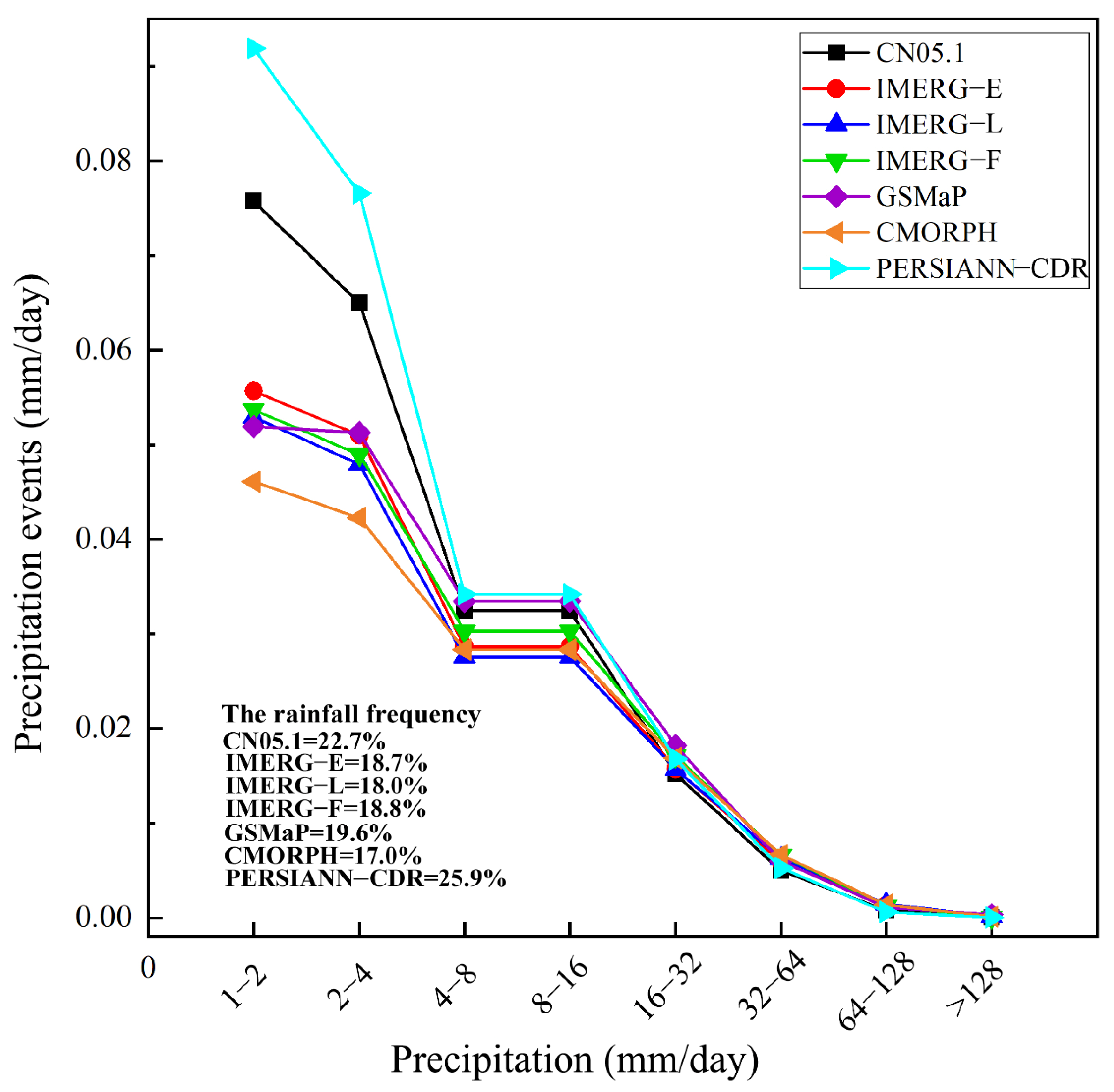

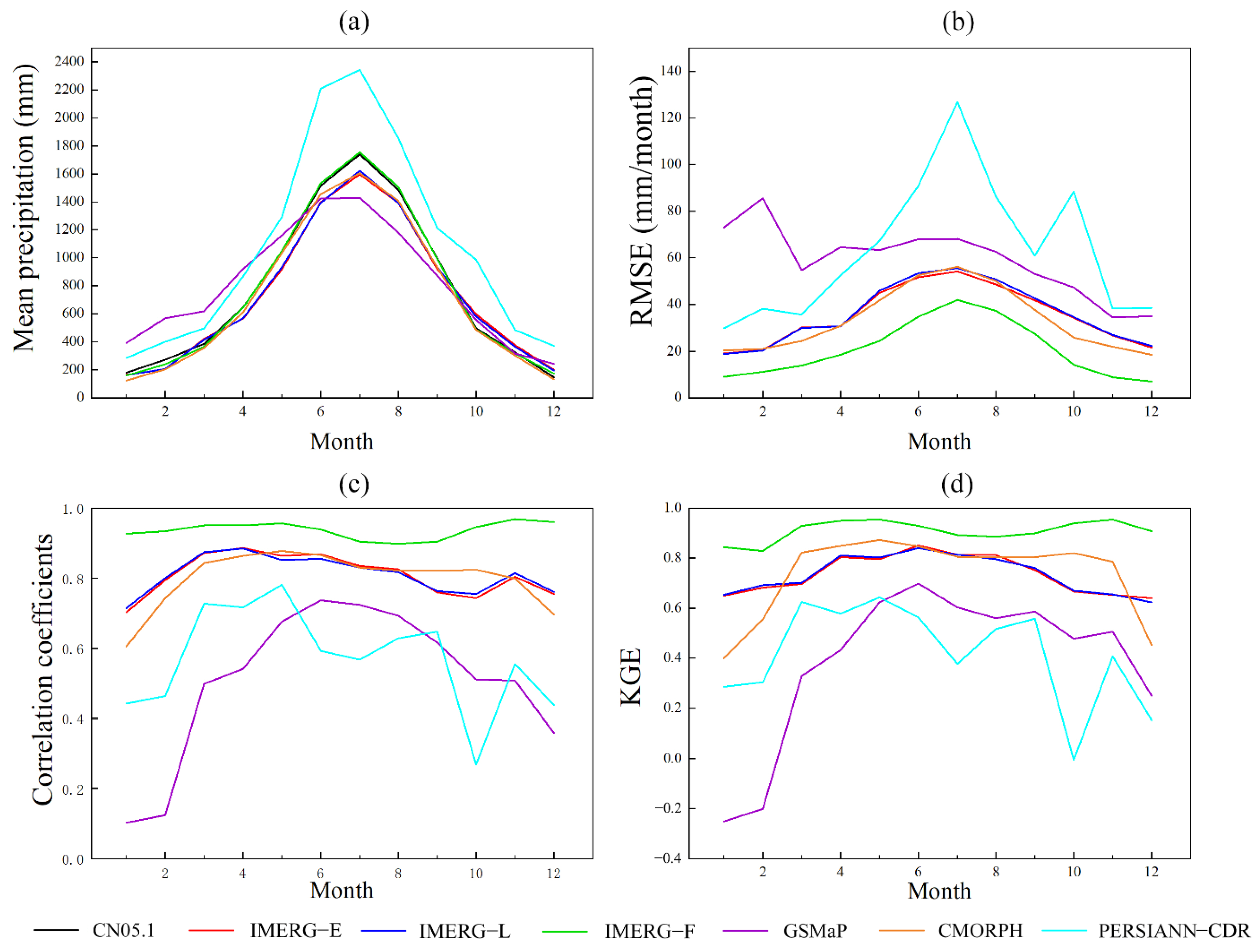

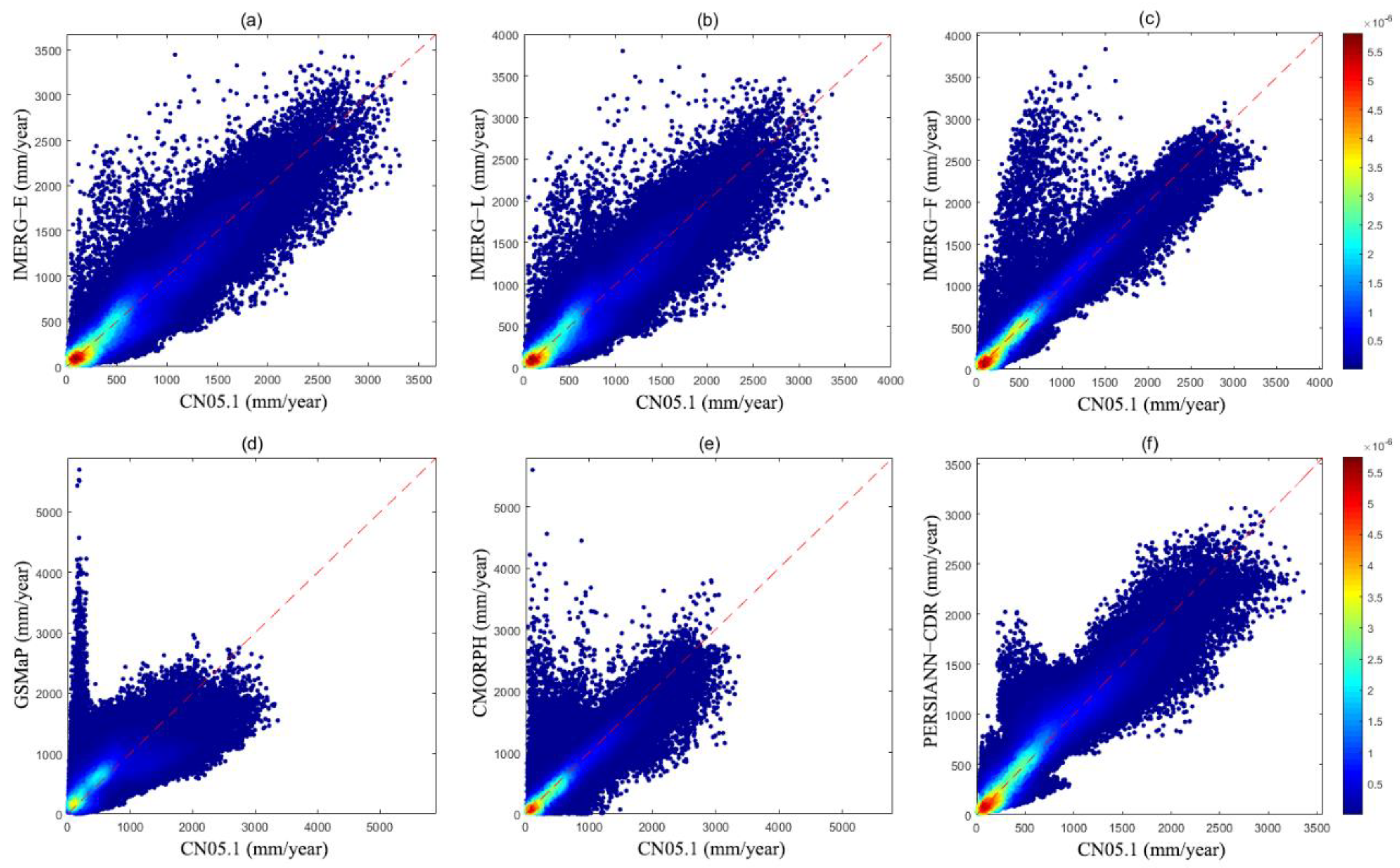
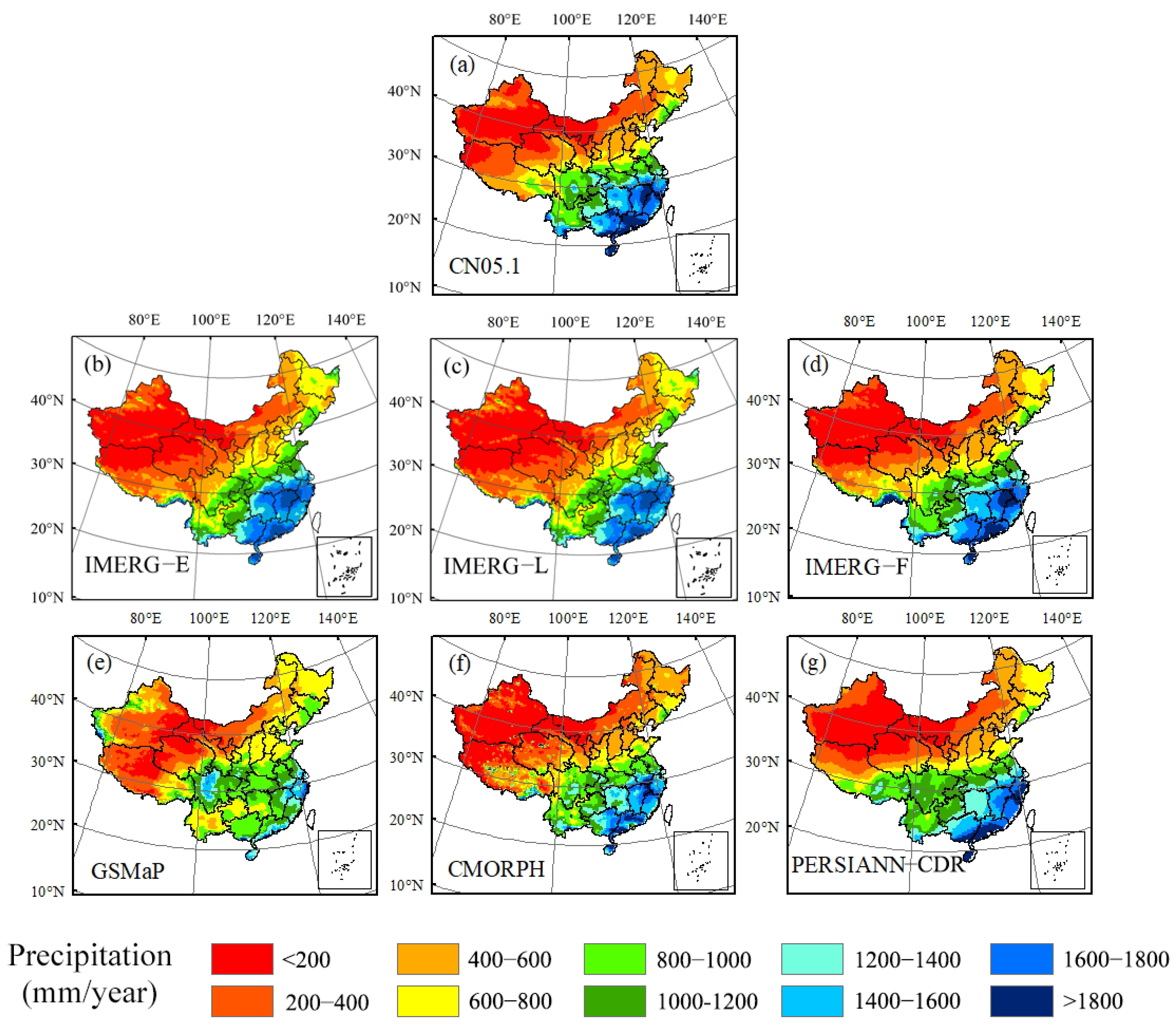
| Name | Resolution | Coverage | Data Source |
|---|---|---|---|
| IMERG–E | 0.1°/Daily | 60°N~60°S | 2000 to present |
| IMERG–L | 0.1°/Daily | 60°N~60°S | 2000 to present |
| IMERG–F | 0.1°/Daily | 60°N~60°S | 2000 to 2021 |
| GSMaP | 0.1°/Daily | 60°N~60°S | 2000 to present |
| CMORPH | 0.25°/Daily | 60°N~60°S | 1998 to 2019 |
| PERSIANN–CDR | 0.25°/Daily | 60°N~60°S | 1983 to present |
| CN05.1 ≥ Threshold | CN05.1 < Threshold | |
|---|---|---|
| Satellite ≥ threshold | Hits | False alarms |
| Satellite < threshold | Misses | Correct negatives |
| RMSE (mm/Day) | ME (mm/Day) | CC | KGE | POD | FAR | |
|---|---|---|---|---|---|---|
| IMERG–E | 5.73 | 0.07 | 0.49 | 0.46 | 0.74 | 0.25 |
| IMERG–L | 5.89 | 0.07 | 0.49 | 0.45 | 0.74 | 0.25 |
| IMERG–F | 5.63 | 0.01 | 0.5 | 0.48 | 0.74 | 0.25 |
| GSMaP | 7.45 | −0.07 | 0.3 | 0.21 | 0.56 | 0.21 |
| CMORPH | 5.91 | 0.12 | 0.46 | 0.43 | 0.38 | 0.21 |
| PERSIANN–CDR | 5.47 | −0.03 | 0.44 | 0.43 | 0.45 | 0.23 |
| RMSE (mm/Month) | ME (mm/Month) | CC | KGE | |
|---|---|---|---|---|
| IMERG–E | 37.32 | 2.2 | 0.87 | 0.86 |
| IMERG–L | 38.17 | 2.12 | 0.86 | 0.85 |
| IMERG–F | 23.79 | 0.31 | 0.95 | 0.94 |
| GSMaP | 60.85 | −2.1 | 0.63 | 0.63 |
| CMORPH | 35.9 | 3.52 | 0.88 | 0.86 |
| PERSIANN–CDR | 69 | −16.42 | 0.68 | 0.48 |
| Season | Data | RMSE (mm/Season) | ME (mm/Season) | CC | KGE |
|---|---|---|---|---|---|
| Spring | IMERG–E | 47.26 | 1.93 | 0.88 | 0.82 |
| IMERG–L | 47.15 | 2.13 | 0.88 | 0.82 | |
| IMERG–F | 27.57 | 4.83 | 0.95 | 0.89 | |
| GSMaP | 161.56 | −48.06 | 0.25 | 0.02 | |
| CMORPH | 50.77 | 10.12 | 0.82 | 0.68 | |
| PERSIANN–CDR | 75.78 | −25.28 | 0.67 | 0.54 | |
| Summer | IMERG–E | 93.49 | 19.32 | 0.91 | 0.87 |
| IMERG–L | 96.72 | 18.39 | 0.90 | 0.86 | |
| IMERG–F | 63.92 | −0.84 | 0.96 | 0.95 | |
| GSMaP | 147.27 | −18.68 | 0.75 | 0.67 | |
| CMORPH | 94.51 | 7.57 | 0.91 | 0.90 | |
| PERSIANN–CDR | 163.53 | −20.39 | 0.77 | 0.72 | |
| Autumn | IMERG–E | 106.32 | 17.61 | 0.86 | 0.84 |
| IMERG–L | 110.96 | 14.99 | 0.85 | 0.84 | |
| IMERG–F | 92.63 | −2.25 | 0.90 | 0.89 | |
| GSMaP | 145.47 | 48.78 | 0.74 | 0.60 | |
| CMORPH | 111.16 | 18.37 | 0.86 | 0.84 | |
| PERSIANN–CDR | 223.64 | −91.91 | 0.64 | 0.51 | |
| Winter | IMERG–E | 59.85 | −12.47 | 0.80 | 0.70 |
| IMERG–L | 59.86 | −10.04 | 0.81 | 0.70 | |
| IMERG–F | 21.31 | 2.03 | 0.97 | 0.95 | |
| GSMaP | 81.08 | −7.30 | 0.52 | 0.51 | |
| CMORPH | 47.65 | 6.20 | 0.83 | 0.79 | |
| PERSIANN–CDR | 125.64 | −59.51 | 0.36 | 0.17 |
| RMSE (mm/Year) | ME (mm/Year) | CC | KGE | |
|---|---|---|---|---|
| IMERG–E | 201.5 | 26.39 | 0.92 | 0.91 |
| IMERG–L | 211.28 | 25.47 | 0.92 | 0.91 |
| IMERG–F | 166.19 | 3.79 | 0.95 | 0.94 |
| GSMaP | 361.22 | −25.63 | 0.72 | 0.63 |
| CMORPH | 219.97 | 42.22 | 0.91 | 0.88 |
| PERSIANN–CDR | 171.77 | −10.17 | 0.94 | 0.93 |
Publisher’s Note: MDPI stays neutral with regard to jurisdictional claims in published maps and institutional affiliations. |
© 2022 by the authors. Licensee MDPI, Basel, Switzerland. This article is an open access article distributed under the terms and conditions of the Creative Commons Attribution (CC BY) license (https://creativecommons.org/licenses/by/4.0/).
Share and Cite
Liu, Z.; Di, Z.; Qin, P.; Zhang, S.; Ma, Q. Evaluation of Six Satellite Precipitation Products over the Chinese Mainland. Remote Sens. 2022, 14, 6277. https://doi.org/10.3390/rs14246277
Liu Z, Di Z, Qin P, Zhang S, Ma Q. Evaluation of Six Satellite Precipitation Products over the Chinese Mainland. Remote Sensing. 2022; 14(24):6277. https://doi.org/10.3390/rs14246277
Chicago/Turabian StyleLiu, Zhenwei, Zhenhua Di, Peihua Qin, Shenglei Zhang, and Qian Ma. 2022. "Evaluation of Six Satellite Precipitation Products over the Chinese Mainland" Remote Sensing 14, no. 24: 6277. https://doi.org/10.3390/rs14246277
APA StyleLiu, Z., Di, Z., Qin, P., Zhang, S., & Ma, Q. (2022). Evaluation of Six Satellite Precipitation Products over the Chinese Mainland. Remote Sensing, 14(24), 6277. https://doi.org/10.3390/rs14246277







